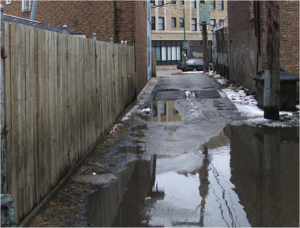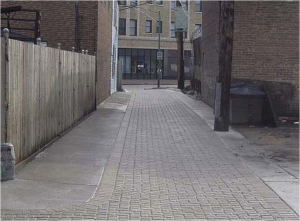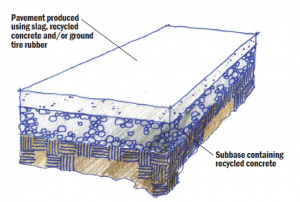Chicago has committed to make its built environment greener and more sustainable. Chicago’s Department of Transportation (CDOT) is changing the city’s urban landscape with green infrastructure improvements to its alleys. Alleys make up a significant portion of Chicago’s impervious surface coverage: about 3,500 acres of impermeable surface, with about 1,900 miles of back alleys for garbage collection, loading, and parking according to Janet Attarian, sustainability coordinator with the Chicago Department of Transportation.Most alleys in Chicago were built without connection to sewers, so they were built with pitched edges to funnel water to main streets. Over time, alleys in the city have deteriorated and rainwater puddles and can flood buildings. Routine capital improvements to alleys presented an opportunity for the city: rather than continuing to overload the sewer system with stormwater and pay to filter it through water treatment facilities, why not infiltrate the water back into the water system? Attarian explained that the city takes about a billion gallons of water from Lake Michigan every year. In addition to stormwater benefits, green alleys can include light-colored pavement, increasing the albedo, which helps reduce negative effects from the urban heat island effect.
CDOT started its Green Alley program in 2006 with six pilot alley projects. Every alley that CDOT reconstructed in 2007 incorporated some aspect of the pilot program, and the city is currently on target to continue that trend (Landscape Online).

Alley with impermeable pavement and poor drainage. (From CDOT’s Green Alley Handbook)

Alley incorporating green alley principles. (From CDOT’s Green Alley Handbook)
Cost and Maintenance
The cost for permeable pavement has lowered in recent years as its becoming a more popular paving material and the city pays about $45 a cubic yard for permeable concrete—compared to conventional concrete at $50 or more a cubic yard. The permeable pavement also requires a stone filtration layer beneath it.
Incorporating stormwater management practices throughout the city would also reduce the need for costly, and difficult, expansion of sewer systems and water treatment facilities.
Permeable pavement requires maintenance, as regular alleys do, to ensure the pores do not get clogged. For Chicago’s snowy winters, salt can still be used to manage snow, but gritty materials like sand would clog the pavement. Permeable pavement is “warmer” than conventional pavement since air circulates with the earth and ice cover can be reduced.
Green Infrastructure as a Solution
Overloading stormwater systems is a reality in cities, since they have a lot of impervious surfaces. Green infrastructure can capture and infiltrate water to prevent overloading the system.
Here’s how permeable pavement works (from the Green Alley Handbook):
“Permeable pavement has pores or openings that allow water to pass through the surface and percolate through the existing subsoil. Permeable pavement comes in the form of permeable asphalt, permeable concrete, and permeable pavers. In areas where soils do not drain freely, permeable pavement can be used in combination with subsurface drainage systems, like pipe underdrains or stormwater infiltration trenches to slow runoff and reduce stress on the combined sewer system.”

Chicago as a Model
In the past several years, Chicago has also has built 90 miles of landscaped medians and refurbished more than 100 miles of streetscapes. (NY Times). In July 2013, CDOT released its Sustainable Urban Infrastructure Guidelines that require sustainable design to be considered in all of its projects. Chicago has come a long way in a short timeframe from piloting six green alleys to now institutionalizing sustainable principles in all of its capital projects. The Green Alley Handbook and Sustainable Urban Infrastructure Guidelines can be great resources for other cities looking to save some green while going green.
